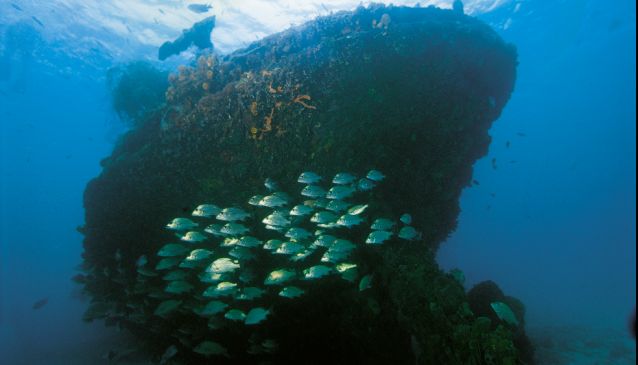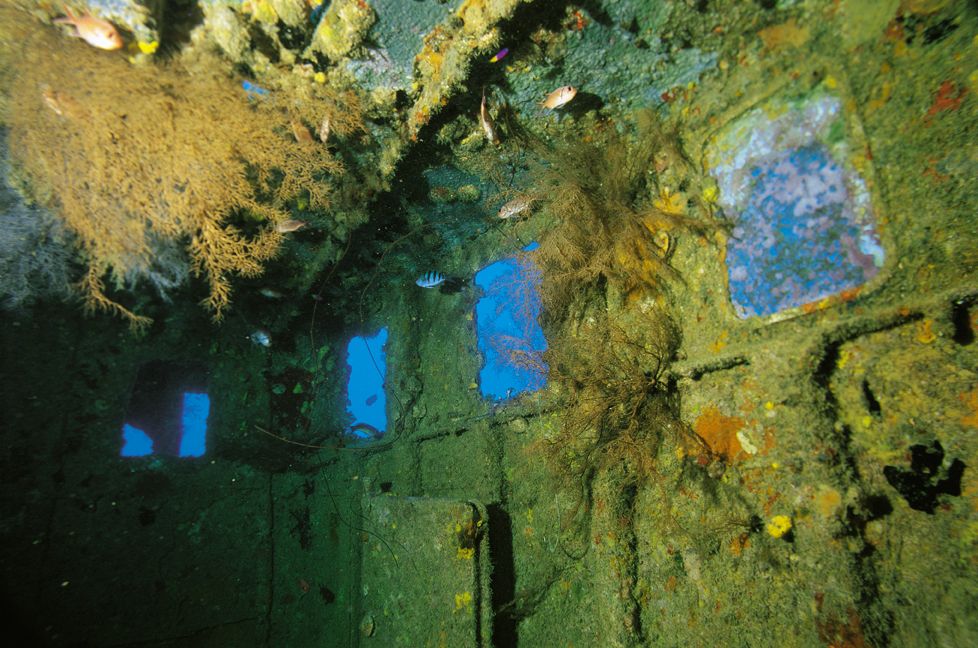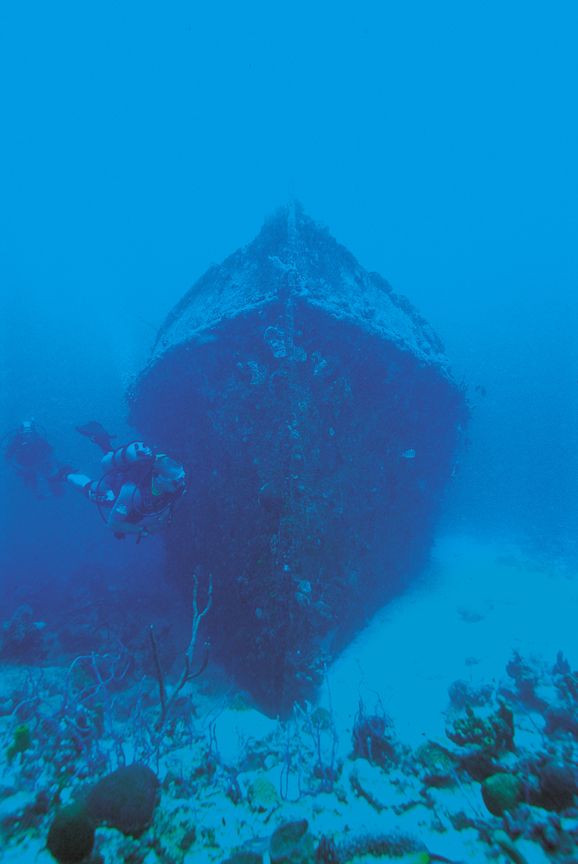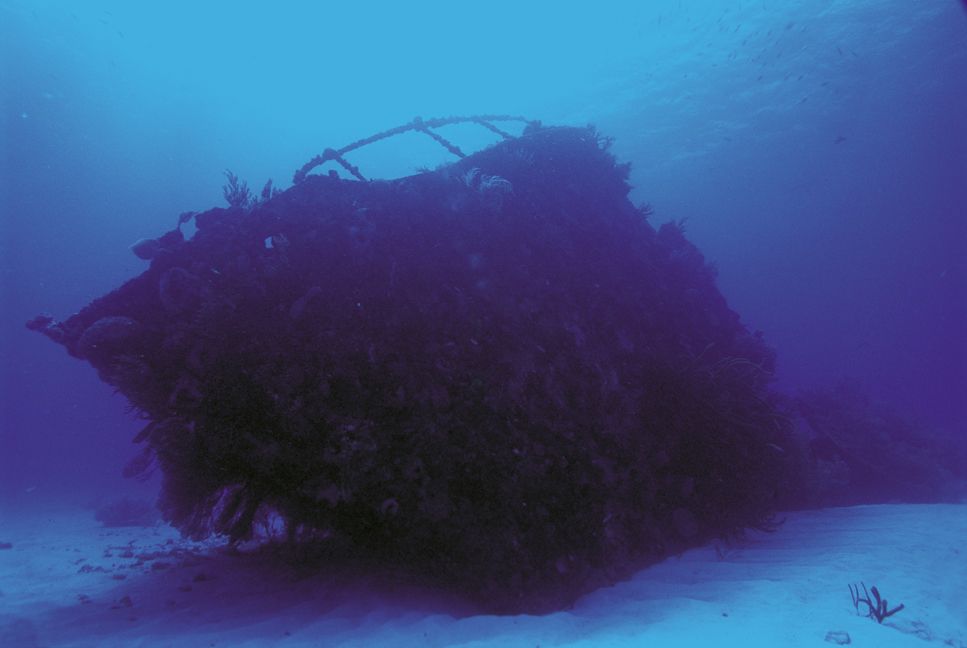Pirates, treasure chests and dancing barracudas

A mention of the word "shipwreck" will usually grasp the immediate attention of anybody within earshot. Very few things can hold greater fascination than the mystery of a ship which has rested on the sea-bed for hundreds of years - especially, when they are identified as a treasure-galleon, pirateer or man-of-war.
The waters around Barbados are teeming with such compelling historical interest. Over 200 ships have been wrecked here since 1666 when a large English warship became one of the first ever recorded victims. By and large, the majority of ships are wrecked during hurricanes and other great storms - often with disastrous proportions, such as 1694 when a hurricane sank 26 merchant ships in Carlisle Bay. Less frequent but more dramatic are occasions like the year 1716 when Captain Martel's pirate ship sank a sloop at the entrance to Carlisle Bay. The pirates themselves were then pursued by an English warship which eventually caught and sank them by cannon fire somewhere off the East Coast of the island.

Pamir Bridge
Barbados undoubtedly has the best collection of wrecks to dive in the Caribbean. Standing above all others, quite literally, and considered the ultimate wreck dive in Barbados, is the ghost-ship SS Stavronikita, a 365 foot long freighter which was sunk on purpose in 1978. She was so skillfully sunk that she lies upright, intact on a sandy bed with her keel resting at 130 feet. This impressive wreck needs 5 or 6 dives to see everything, as the Stav – as she is otherwise known – is so big and so deep that it limits bottom time.
The buoy is tied to the forward mast, which comes within 20 feet of the surface. Most dive operators attach a reserve bottle to the rope in case a diver needs some extra air to finish their safety stop. The mast structure resembles a long legged giant and is encrusted with a variety of colourful sponges and a forest of hydroids – among them branching, feather and slender varieties.
On the pre-dive chat you may be given the option of taking the deeper internal tour of the wreck, which starts at the prop at 130 feet, or the shallower option, still 95 feet, in the top deck area. For those of you that like the thrill of going deep inside a wreck, speak to the dive leader beforehand as he may be able to take you to the engine room if your group is small enough and experienced enough. There are some very tight holes to pass through to get there but when you see the beam of light shining through, it is truly a unique experience. Massive holes in the hull let in valuable light that penetrates the interior and pieces of hull are strewn on the sea bed below.

Coombermere
In the lower stern area the Stav is covered in encrusting sponges, gorgonias and black coral strands and the rudder and propeller are clearly visible. There is a large hole on the lower starboard side near the propeller where the deeper internal tour begins. Under the guidance of a dive leader the group is led up through a number of cabins, corridors and compartments to emerge in the cargo hold. There is an alternative dive route – through the upper deck cabins and hatches – and this dive only goes as deep as 100 feet, also ending in the forward cargo hold in front of the bridge. Unfortunately, the bridge is no longer accessible due to the fragile condition of this metal structure.
Other places to explore are three large open cargo holds. It is said the bow hold is home to a giant turtle. Above the mid-ship hold lies a horizontal beam covered in deep sea gorgonias, which have grown at a diagonal angle to take full advantage of the prevailing current. An amazing large barracuda is often seen around this area, "George", dancing on his tail, staring upwards at his own image reflected in a bubble of trapped air.
The picturesque Carlisle Bay lies just south of Bridgetown and is the resting place of six wrecks of varying ages and sizes. The whole area has recently been made into a marine park and is one of the few places where divers and snorkelers can access the wrecks from the beach. It is possible, with the guidance of a good dive leader, to see all 6 wrecks on one dive. Four wrecks were sunk purposely, the most recent one the Bajan Queen in May 2002. This marine park is regularly used as a night and afternoon dive venue and is excellent for all aspects of photography.
There is something for everyone on this dive site because each wreck is different from the others. Some are big and made of steel while others are small and made of cement, steel or wood. Some have been down since 1919 while others are relative newcomers. They all attract their own distinct marine life and many wrecks host a variety of fish schools and brightly coloured encrusting sponges. Colonies of multi-coloured christmas tree worms and beautiful pink and lilac finger sponge are also common features.
There are two other wrecks that are in fact sister ships; the Pamir, located on the west coast, and the Friar’s Craig on the south coast. They were both deliberately sunk for divers in 1985 but the Pamir has fared better, remaining completely intact, while the Friar’s Craig has broken into three large mangled pieces. Nevertheless, they both provide excellent man-made reefs, hosting a multitude of marine creatures.

Friars Craig Wreck
The Pamir is a 170 foot freighter that was modified for diving and then purposely sunk. She dutifully came to rest upright in a shallow sandy area, perfect for beginner divers and second-tank dives. The bow, which lies at 40 feet, faces the beach while the curved stern is firmly buried in sand in about 50 feet of water. The entire wreck is covered with encrusting sponges of various colours. Black coral and sea fans have attached themselves to the hull on the port side of the stern. In the central area there is a large open cargo hold where it is possible to see grunts, blackbar soldierfish, trumpet fish, squid and sergeant major fish.
The sergeant major fish are a particularly renowned attraction of the wreck and they provide excellent photographic subjects. The flat surface walls of the wreck are perfect for them to lay their purple egg clusters, which they seem to do throughout the year. As soon as the eggs are laid, the mating pair then spends every waking moment protecting their potential offspring from hungry fish, even their own species. If a diver swims too close to a cluster they are liable to receive an aggressive darting attack, so look out! They are, however, only 3 inches in length and therefore do not present any real danger.
The hull of the Pamir has many large holes so divers can enter and exit with ease. The internal fittings have been removed so there is very little for diving equipment to snag on.
This is a perfect wreck to ‘cut your teeth on’ if you have never dived a wreck before, but equally, there is a lot to see and explore for the experienced diver. The bridge is quite large and open with one surviving window at the front, which is surrounded by pink coloured black coral….
…Because of the large holes in the hull there is plenty of light inside the wreck, which means there is no need to carry a torch. However a torch light does come in handy if you want to see the true brilliance of the coloured sponges and invertebrates which have taken over the ship.
There is a large winch in the centre of the cargo hold which is home to spiny lobster, banded coral shrimps, feather dusters, tube worms and an elusive small, white frogfish.
A small school of yellow goatfish hover under the curvature of the bow amongst a scattering of coral heads and barrel sponges. Standing at attention, a huge old-fashioned anchor lies upright in the sand at the bow. It is covered by a large multi-angled barrel sponge which, in turn, plays host to shrimp, gobbies and other small reef creatures.
Pelagic fish such as spanish mackerel, barracuda and bar jack can often be seen cruising the wreck and reef area. You may also see another strange fish called a flying gurnard. They are not often found swimming around but they frequent the seabed in search of food. These fish are about 12 inches long; they have large eyes and mottled brown backs and are relatively unattractive. However, when they extend their six-inch wings, they are totally transformed into a mesmerizing technicolour of luminescent blue and green.
Popping their heads up from the sand along the port side of the wreck is a colony of garden eels. If approached carefully, crouching on the sand, it is possible to get within a few feet of them.
The surrounding reef is in good condition and supports a multitude of marine life. There are 4 species of sea anemones, on and around the wreck, and inhabiting them at least 2 species of shrimp – all perfect for macro photography. If you look closely you can find beautiful lettuce leaf slugs and brightly coloured fire worms, crawling across the reef.
At the end of the dive, when it is necessary to do a safety stop at 15 feet, hundreds of brown chromis and blue fusiliers, who inhabit the water above the wreck, come into view. Previously unnoticed, they provide a much needed service by feeding on floating algae and plankton, which in turn improves visibility.
*Edited excerpt with the kind permission of Lucy Agace, from her book, Barbados Dive Guide - available at book stores and dive shops around the island. Alternatively, you can order your copy online here.